BEHIND THE ORANGE CURTAIN: 20 INNERMOST SECRETS OF THE 2022 KTM 450SXF FACTORY EDITION
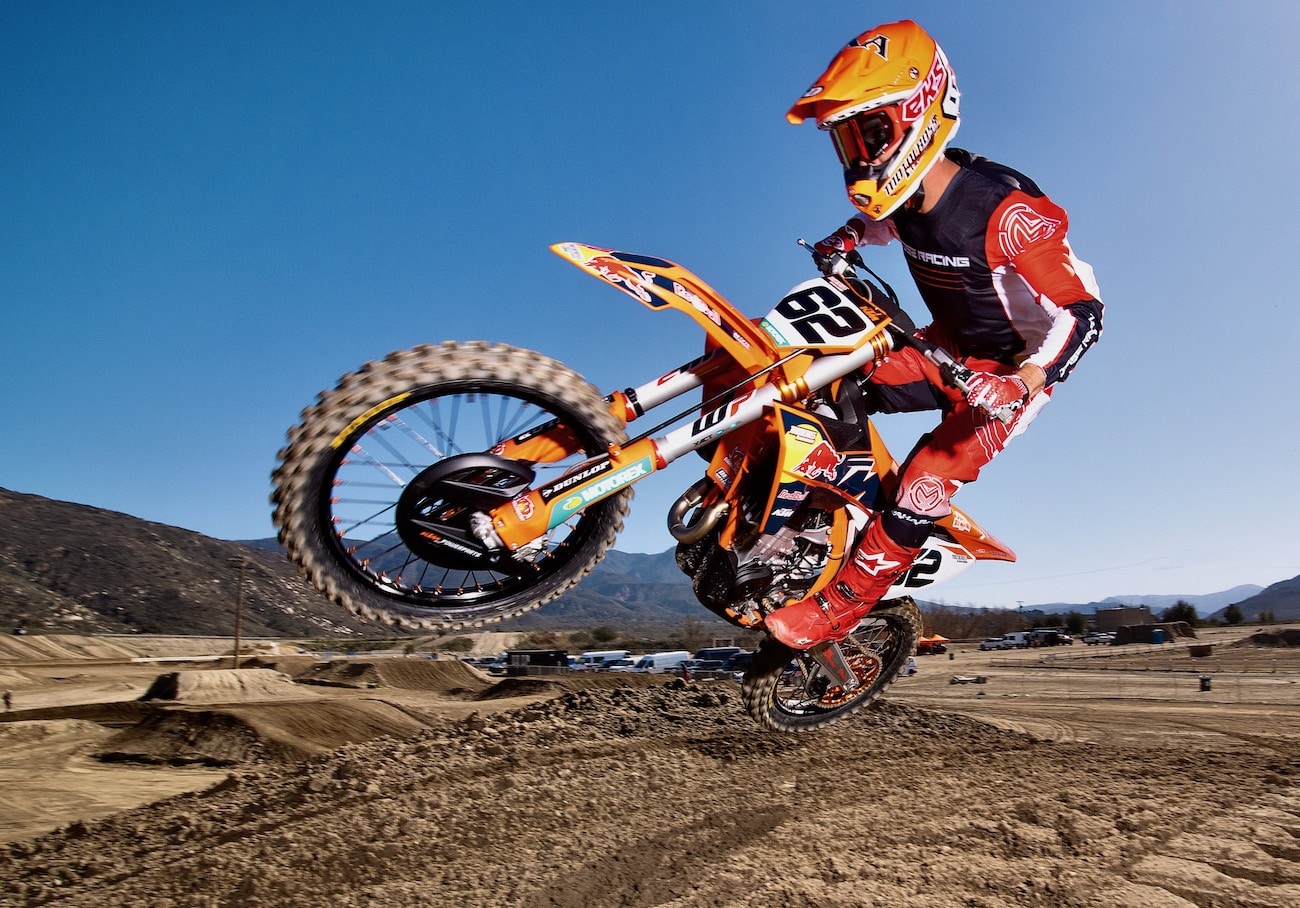 Historically the Factory Edition is a precursor of what is to come the following production year from KTM.
Historically the Factory Edition is a precursor of what is to come the following production year from KTM.
If there is one thing that the motocross community has learned over the last decade, it is that the KTM 450SXF Factory Edition is a surefire clue as to what next year’s KTM 450SXF will look like. Oh, don’t get it wrong; it won’t necessarily have the orange seat, Factory split triple clamps, Red Bull graphics, front rotor guard, holeshot device, skid plate, Factory Powerparts wheels or even the orange frame, but the meat and potatoes is all next year’s machine. And, the 2022-1/2 KTM 450 Factory Edition is a very special machine, because apart from the bling and orange fluff that catches your eye, the chassis, engine, running gear and layout are all totally new. Getting a KTM 450SXF Factory Edition that is built on all-new components is a rare occurrence, only happening four times in the last 11 years of Factory Edition releases. Very good years to buy a Factory Edition have been 2012, 2015, 2018 and now 2022. The other seven model years were mostly fluff on an existing design. Not so with the 2022-1/2 KTM 450SXF Factory Edition. It is new—really new.
STAY TUNED AS MXA TAKES YOU ON A JOURNEY THROUGH THE TECHNICAL WONDERS OF THE LATEST 450SXF FACTORY EDITION.
(1) Why did KTM downsize the 25mm rear axle to 22mm? During testing, KTM discovered that the new swingarm increased the rigidity of the rear of the bike more than they anticipated during computer analysis. So, they put the smaller rear axle on to provide more feedback from the rear wheel and get the flex back where they wanted it to be.
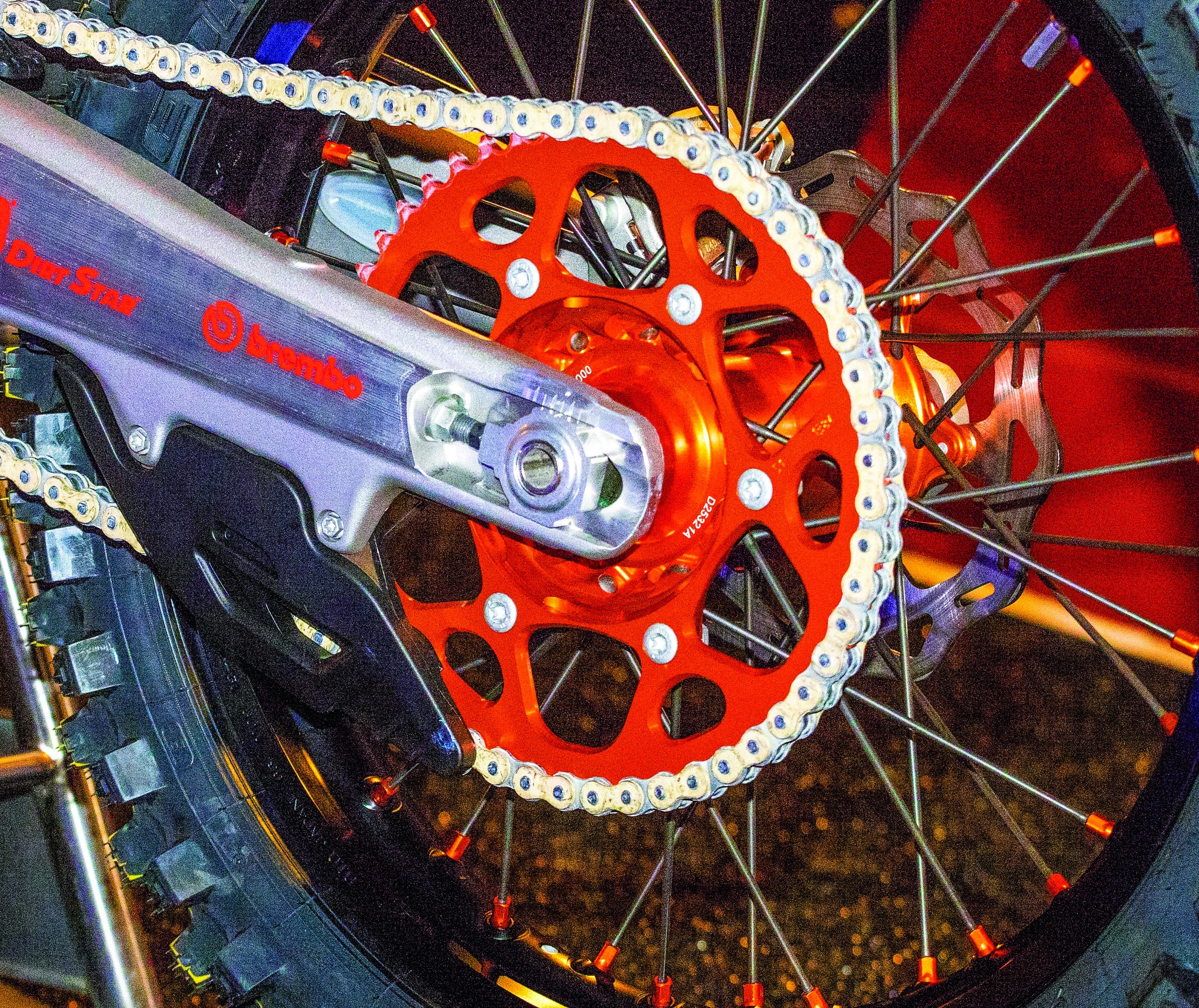 The rear axle has been reduced from 25mm to 22mm to feed more flex into the rear end.
The rear axle has been reduced from 25mm to 22mm to feed more flex into the rear end.
(2) Can you run your 25mm aftermarket rear wheel on the 450SXF Factory Edition or 2023 KTM 450SXF (when it comes out)? Yes, because KTM wheels have the wheel spacers that run on the bearings instead of the axle. All you would need to use your aftermarket 25mm rear wheels the wheel spacers.
 The 2023 WP rear shock can have both low-speed and high-speed compression adjusted by hand.
The 2023 WP rear shock can have both low-speed and high-speed compression adjusted by hand.
(3) Why did KTM shorten the rear shock by 20mm and the shock spring by 20mm? The goal was better overall packaging to fit with the new shock tower design and revised shock linkage, which has its pivots moved up to raise the link arms farther off the ground. Additionally, the new shock/spring combo saves 100 grams (3.5 ounces). Even though the shock and spring are shorter, the shock’s stroke is unchanged from 2021, and the spring rate is still 45 N/mm. It was reported previously that the shock was 15mm shorter (instead of 20mm), but a check of the blueprints revealed that was an error.
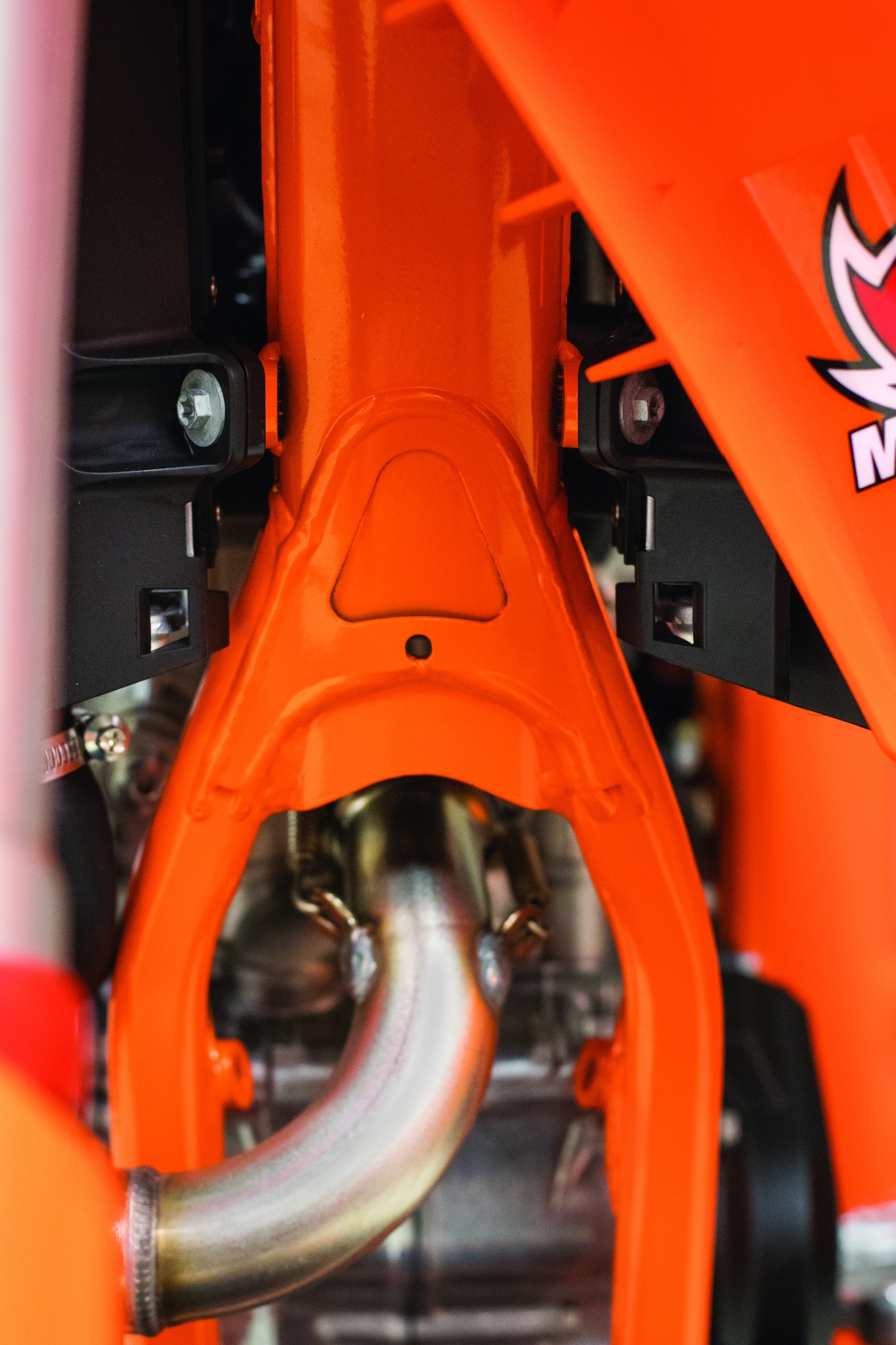 KTM’s stamped steel gusset stiffens the two down tubes. This was tested by the Factory team in 2021 when they welded a tube between the down tubes in 2021. There is no doubt that the Factory Edition frame is stiffer and more rigid. It will take a longer break-in time to make it as comfortable as the flexier 2022 frame.
KTM’s stamped steel gusset stiffens the two down tubes. This was tested by the Factory team in 2021 when they welded a tube between the down tubes in 2021. There is no doubt that the Factory Edition frame is stiffer and more rigid. It will take a longer break-in time to make it as comfortable as the flexier 2022 frame.
(4) Does the stamped gusset plate between the frame’s front down tubes have anything to do with the welded-on cross-brace that the factory bikes were running during the 2021 season? Yes, but it is much more precise than the factory team’s welded crossbar. Since the front of the 2023 frame’s head tube section is forged as one piece, there is less need to rely on welds. The lack of welds makes flex in this area more consistently predictable, especially the increase in torsional rigidity. And, from an R&D perspective, the stamped plate makes it much simpler to test the flex characteristics of future frames by changing one piece instead of all the head tube components.
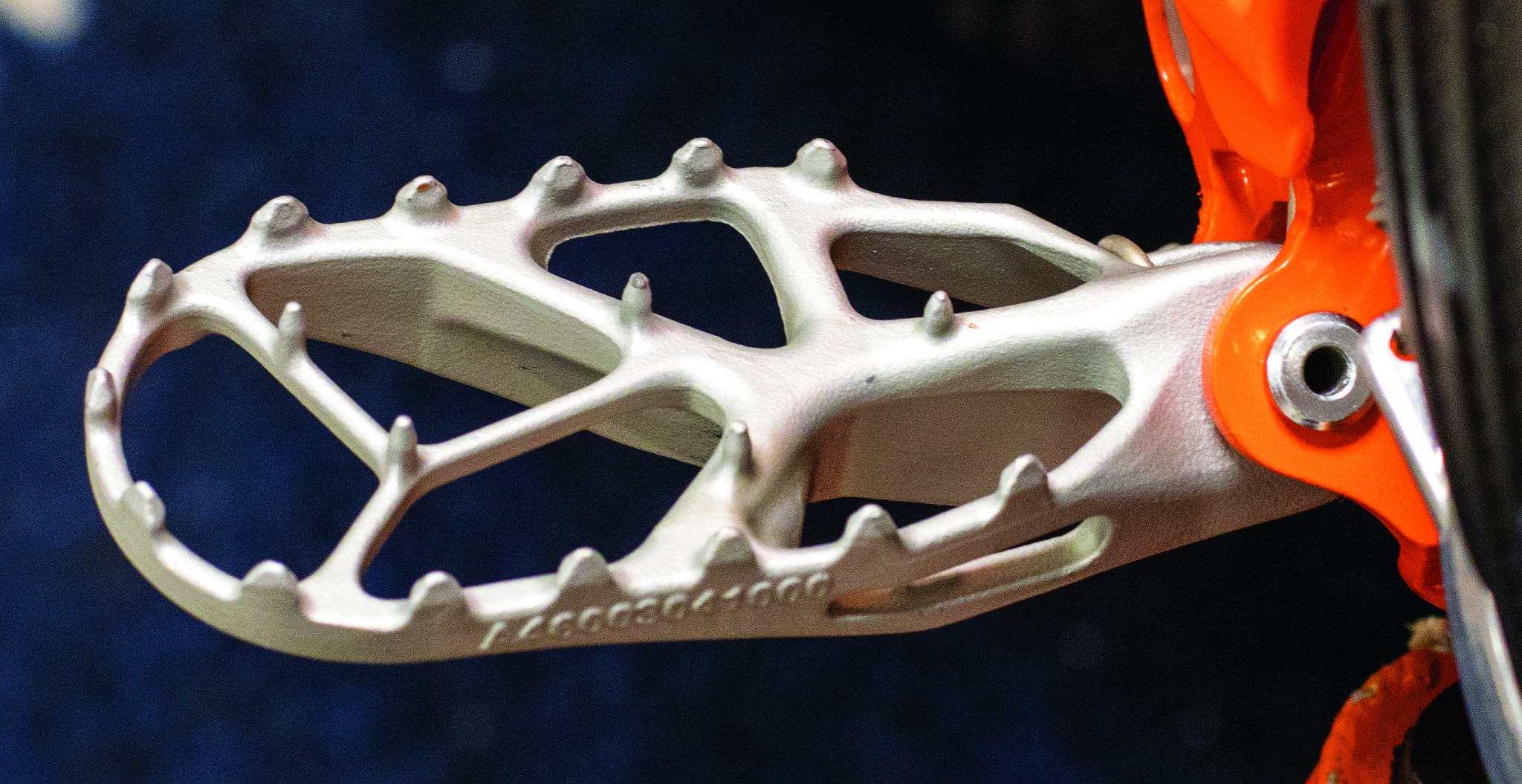 By mounting the footpegs inboard on the frame, the new footpegs are longer and lighter, but paradoxically don’t stick out any farther.
By mounting the footpegs inboard on the frame, the new footpegs are longer and lighter, but paradoxically don’t stick out any farther.
(5) Why do the footpegs change shape along their length? And if they are longer, aren’t they going to catch on the ground? It is true that the footpegs themselves are 7.5mm longer, and they do change their width as they extend outward, but they will not hit berms or hay bales more than before because the footpeg mounts have been redesigned to fit closer and tighter to the lower frame rails. The narrow shape of the footpegs saves weight, while the flare as they extend out provides more solid footing for the rider’s feet.
 The front and lower motor mounts were built into the frame from forgings, while the head stays are forged aluminum. The all-new frame and engine cases were designed simultaneously to work together. The new frame accepts both the 450SXF and 250SXF engines (shown) thanks to re-engineered engine case.
The front and lower motor mounts were built into the frame from forgings, while the head stays are forged aluminum. The all-new frame and engine cases were designed simultaneously to work together. The new frame accepts both the 450SXF and 250SXF engines (shown) thanks to re-engineered engine case.
(6) What are the motor mounts and head stays made from? The motor mounts are forged chromoly steel, while the head stays are forged aluminum. An interesting side note is that the 2023 450SXF and 250SXF will share the same frame. Unlike lots of 250 four-stokes that stick the smaller 250 engine in the larger 450 frame, which can affect the handling of the 250 because of poor engine placement, KTM designed totally new 250 and 450 engines and cast the 450 cases smaller so that the positions of the motor mount bosses on both engines were in the exact same location. This allowed KTM to make the frame shorter, especially on the down tubes, so that both engines will fit perfectly in the exact same frame.
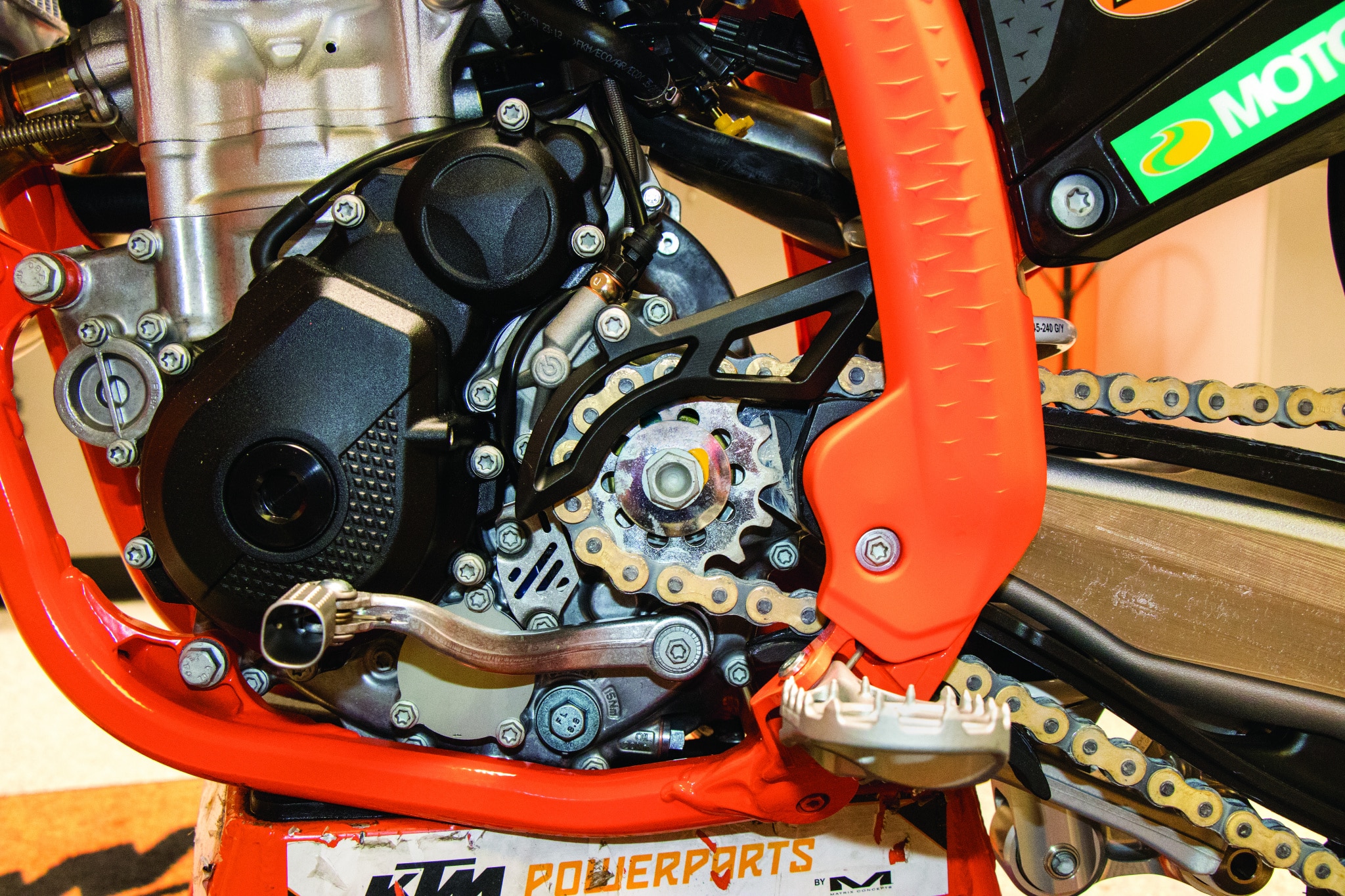 The countershaft is lowered 3mm to lessen chain torque.
The countershaft is lowered 3mm to lessen chain torque.
(7) Why did KTM move the countershaft sprocket down 3mm on the 2022 450SXF engine? KTM wanted to reduce rear-end squat under full loads of power. Using the anti-chain torque theories of Horst Leitner and Eyvind Boyesen, they realized that rear-end squat, the tendency of the rear suspension to drop under acceleration, was a byproduct of the bike’s chain line (as determined by the angle the chain follows from the highest point on the rear sprocket to the highest point in the countershaft sprocket). Changing the chain line, by either raising the swingarm pivot on the frame or lowering the countershaft sprocket on the engine, greatly reduces squat.
Back during the Honda CR250 two-stroke days, Honda suffered from too much rear-suspension squat and raised its swingarm pivot up several millimeters to change the chain line. KTM didn’t want to change the angle of the swingarm in relation to the chassis, and since they were casting brand-new engines, they found it more expedient to change the countershaft position. For the KTM Factory race team, reducing squat means that the KTM should be able to go through Supercross whoops with less packing on consecutive whoops. It seems to be working for Marvin Musquin in the 2022 Supercross series.
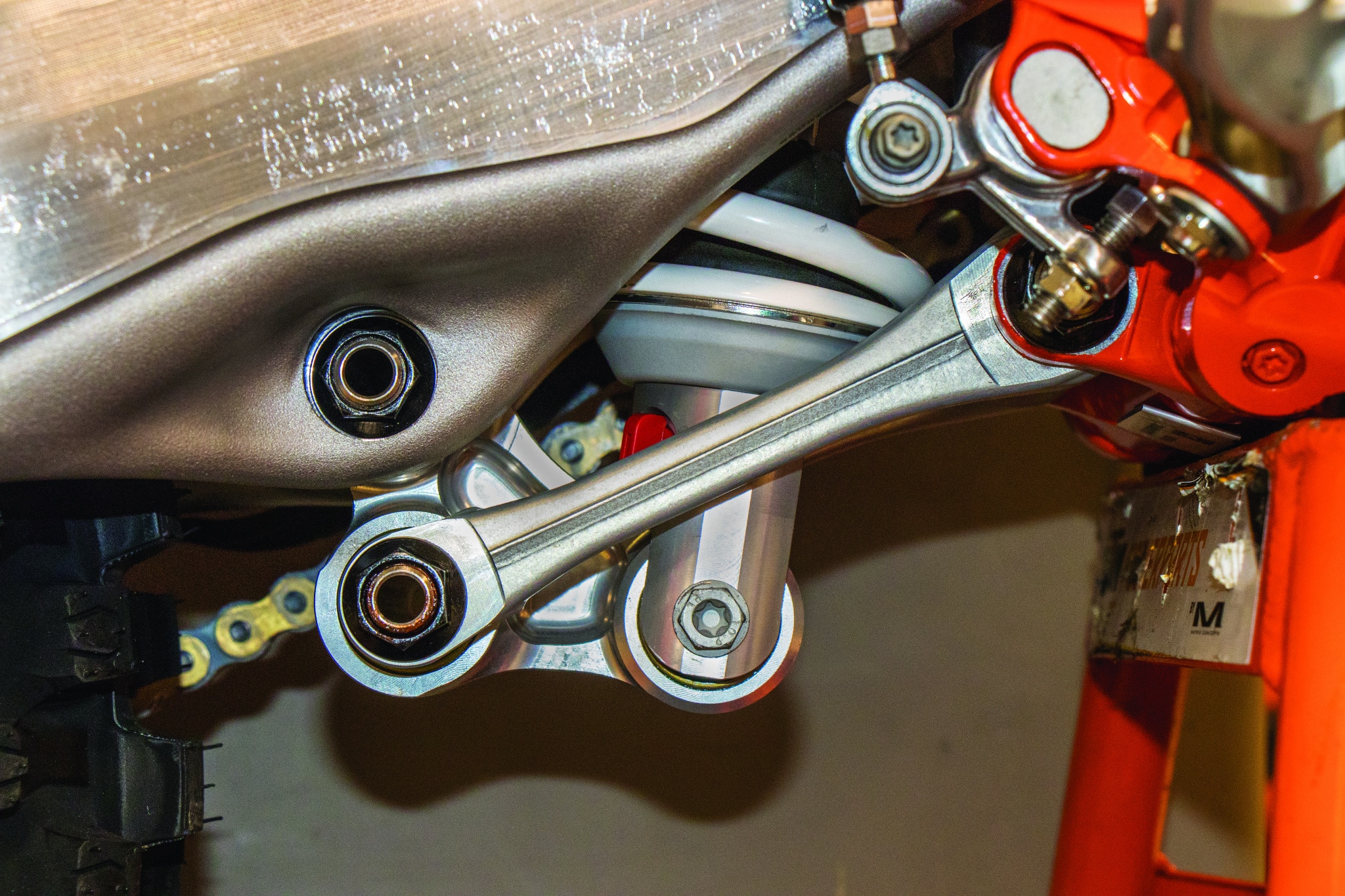 The shock linkage has been raised up and the pivots moved for more clearance, while the shock and spring have been shortened.
The shock linkage has been raised up and the pivots moved for more clearance, while the shock and spring have been shortened.
(8) If the shock linkage has all-new pivot points and is tucked up higher under the frame, how different is the rising-rate curve? It is the same as it was for the 2021 450SXF. Moving the linkage up was done to reduce stiction on the link arms, which lessens wear, but mostly to stop the shock linkage from hitting against berms, rocks or other obstacles.
 Note that the frame’s oval backbone does not extend all the way to the shock tower. The goal is to lessen rear end kicking, especially in the whoops, by lessening the shock’s forward energy. What you can’t see is that the head tube is triangular-shaped and the supporting gussets, above and below the head tube, are not stamped metal, but are instead forged.
Note that the frame’s oval backbone does not extend all the way to the shock tower. The goal is to lessen rear end kicking, especially in the whoops, by lessening the shock’s forward energy. What you can’t see is that the head tube is triangular-shaped and the supporting gussets, above and below the head tube, are not stamped metal, but are instead forged.
(9) Are our eyes deceiving us, or does the 2023 frame’s backbone stop short of connecting to the shock tower? The 2023 shock tower is no longer connected to the frame’s backbone; instead, the backbone and shock tower have been separated, with the backbone splitting into parallel frame tubes. This improves the chassis’ flex characteristics and reduces the effect of square-edge bumps, whoops and kickers.
If you are old enough to remember the original 1975 Yamaha Monoshock, which had a very long shock absorber mounted to the head tube, you will remember “Yamahop.” All the energy transmitted through the Monoshock went straight to the head tube, which loaded the front of the bike while lightening the rear, causing the rear end to kick. KTM’s separation of the frame’s backbone from the shock tower lessens the energy that affects the chassis’ balance.
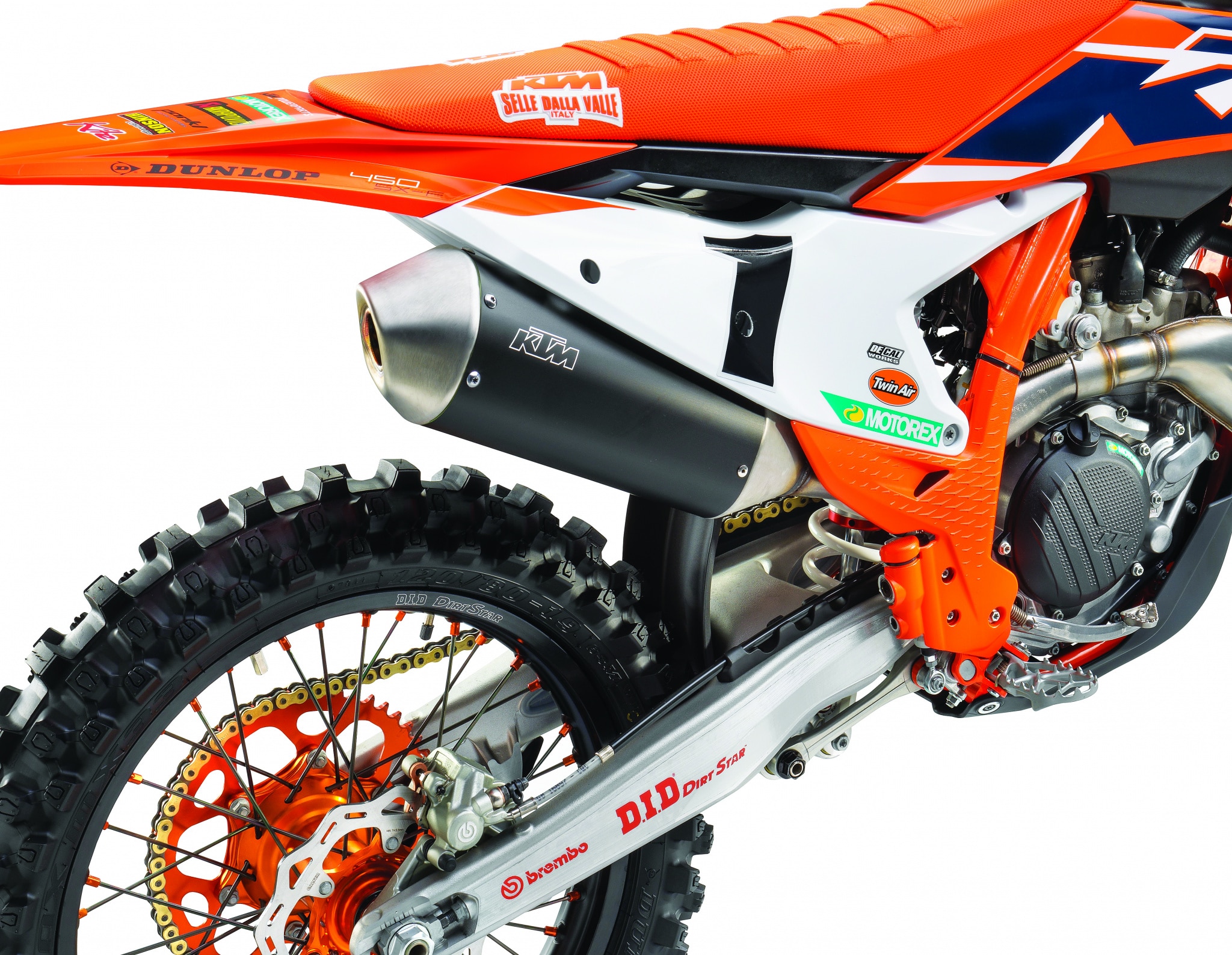 What looks like handholds below the seat are really enlarged air vents designed to insure that airflow comes into the airbox from above.
What looks like handholds below the seat are really enlarged air vents designed to insure that airflow comes into the airbox from above.
(10) Can you actually pick the KTM 450SXF up with the handholds cut into the side panels? We don’t think so! Eight years ago, Husaberg, which was owned by KTM, had identical handholds in the exact same location, and there was not enough leverage to lift the rear wheel up onto a bike stand. In truth, the faux handholds are really there to channel a consistent flow of air to the airbox. On the 2021 and previous KTM airboxes, most of the air entering the airbox came from “undefined” sources (around the battery box, under the seat or through the single side vent). For 2023, KTM wants to unify the airflow and increase it at the same time.
(11) Are there different maps for each gear? Yes. The 2023 KTM 450SXF has a unique map for each gear. Additionally, the ECU has the IG-ACC feature that advances the ignition timing above and beyond where it would ever be in normal riding when the throttle goes from closed to open (and it does not work any other time). By advancing the ignition timing every time you turn the throttle from closed to open, you get an added boost of juice.
(12) Are there any other tricks in the KTM fuel-injection system? Yes. Split injection was put into KTM’s fuel-injection system in 2019—although few people knew about it. Split injection breaks the long burst of fuel spraying out of the injector nozzles into two halves. The first short-duration spray cools the back of the intake valves, so the following long-duration spritz has a denser air/fuel mixture to work with. This results in more usable power across the midrange.
(13) Is KTM’s new Quick Shift a gimmick? No, Quick Shift has been used on KTM adventure models and the Duke 390, 690, 890 and 1290 street bikes, but it has been available on different brands also. It dates back to road racing in the 1960s and early 1970 when road racers would touch their kill buttons with the thumb of their left hand every time they upshifted. Momentarily killing the engine relieved back pressure on the transmission gears that in the 1970s didn’t like to shift when the throttle was wide open. Quick Shift functions the same way. It interrupts the ignition via a sensor on the shift drum that then sends a signal to the ECU to cut the ignition for a split second to allow faster clutch-less shifting. Quick Shift is only active from second to fifth gear, and Quick Shift can be turned on or off by pressing a button on the map switch.
 The 2022-1/2 Husqvarna Rockstar Edition will not have Husky’s lowered suspension settings, but will come instead with KTM-spec forks and shock.
The 2022-1/2 Husqvarna Rockstar Edition will not have Husky’s lowered suspension settings, but will come instead with KTM-spec forks and shock.
(14) Does the Husqvarna Rockstar Edition have the shortened suspension of the production FC450? The Husky Rockstar Edition comes with KTM’s forks, shock and linkage for two reasons: (1) The Husqvarna Rockstar Edition is billed as a team replica, which means it should come with the suspension that the Husqvarna factory team uses, which isn’t shortened. Of course, this is pie in the sky, because none of the factory riders run stock WP XACT air forks. (2) The timing of building the Factory and Rockstar Editions, which was back in November of 2021, meant that it was more efficient to use the same suspension settings on all 800 FC450s and 450SXFs.
 The map switch is downsized from 2021, plus, if you press the QS button the bike will upshift quicker.
The map switch is downsized from 2021, plus, if you press the QS button the bike will upshift quicker.
 The little module with the yellow dot on it is the roll-over sensor.
The little module with the yellow dot on it is the roll-over sensor.
(15) What is a roll-over sensor? All modern four-strokes come with a roll-over sensor. It is designed to shut the engine off if the bike is leaned at an angle greater than 60 degrees for more than 5 seconds. It is a safety feature for a bike that crashes throttle down and keeps running wide open. When it was first introduced in 2008, it didn’t come with the five-second delay, and the test riders discovered that it shut the engine off in mid-air if they whipped it too much. KTM’s roll-over sensor is set for seven seconds.
 Although the head looks lower, it is really just the valve cover that is pushed farther down onto the head.
Although the head looks lower, it is really just the valve cover that is pushed farther down onto the head.
(16) How much more compact is the 2023 450SXF cylinder head? It is not dimensionally different from last year, but the aluminum valve cover is now made from magnesium and slips down over the top of the cylinder farther (plus, it only uses two valve cover bolts instead of three). The result is a 300-gram weight savings, which is an amazing 10.5 ounces; however, the 2023 250SXF engine is 8mm lower, thanks to a bigger bore and shorter stroke (81mm x 48.5mm compared to last year’s 78m x 58.2mm).
 The front wheel of the 2022-1/2 Factory Edition is laced in a stronger cross-3 spoke pattern. This probably won’t be on the 2023 production model.
The front wheel of the 2022-1/2 Factory Edition is laced in a stronger cross-3 spoke pattern. This probably won’t be on the 2023 production model.
(17) Why does the KTM 450SXF Factory Edition have a cross-three spoked wheel on the front, while the 2022 Yamaha YZ450 has its cross-three on the rear? In truth, the optimum setup would be to have the more durable and forgiving cross-threes on both ends, but during testing, each test group, KTM’s and Yamaha’s, selected different wheels.
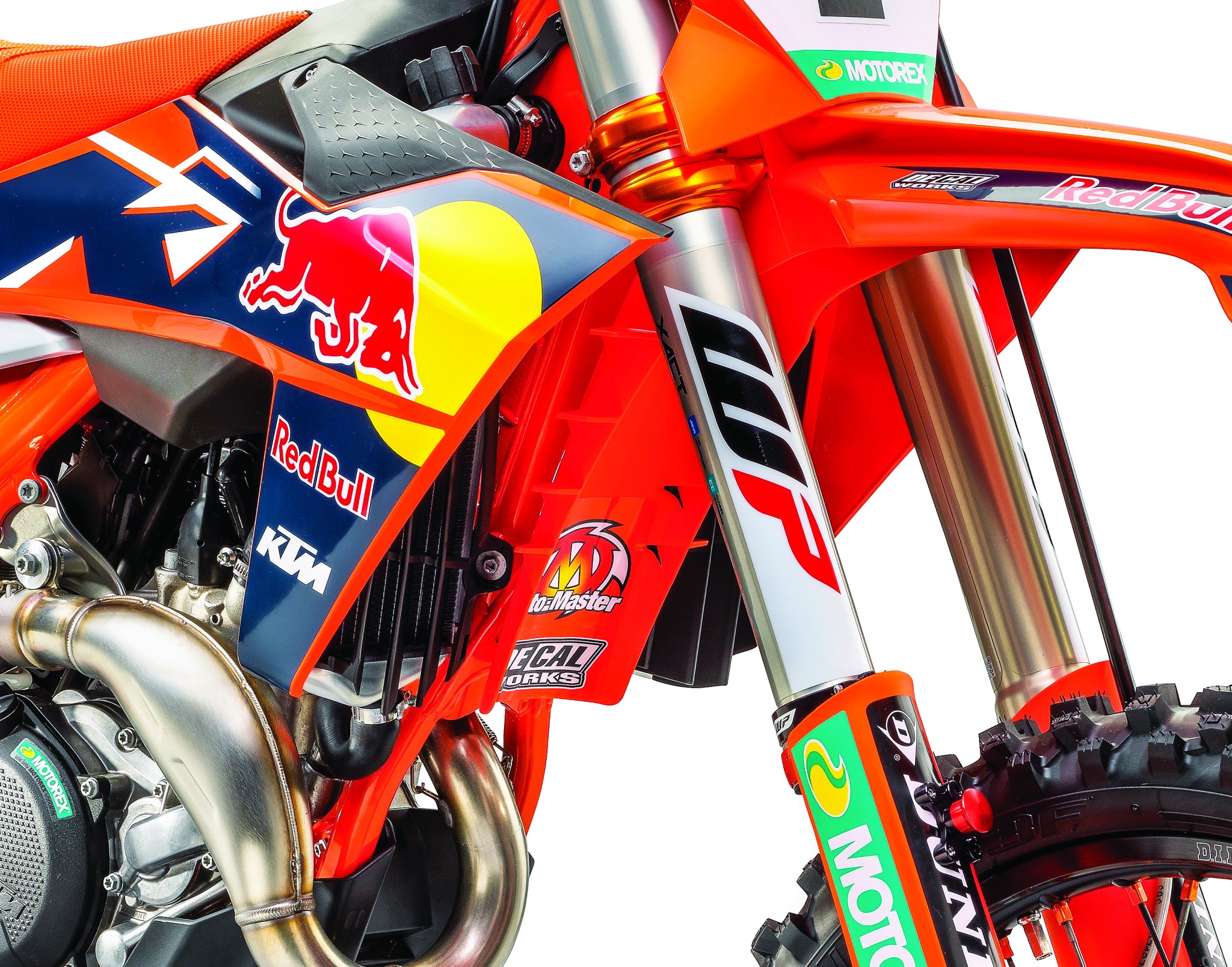 The winglets on the back of the front fender knock down roost that is flug off the front tire, while allowing air into the radiators.
The winglets on the back of the front fender knock down roost that is flug off the front tire, while allowing air into the radiators.
(18) What is up with the weird front fender? The 2023 KTM front fender is designed to cut down on roost coming off of the front tire and spraying back towards the rider. How do they do this? First, the front half of the front fender is 24mm wider than it was last year, while the rear half of the fender is 30mm wider. You can’t help but noticed the four winglets on each side of the rear half of the fender (behind the forks). They serve to widen the rear fender without cutting down on air flow to the radiators. On another positive note, the new fork guards wrap farther around the exposed fork legs to cut down on chrome dings.
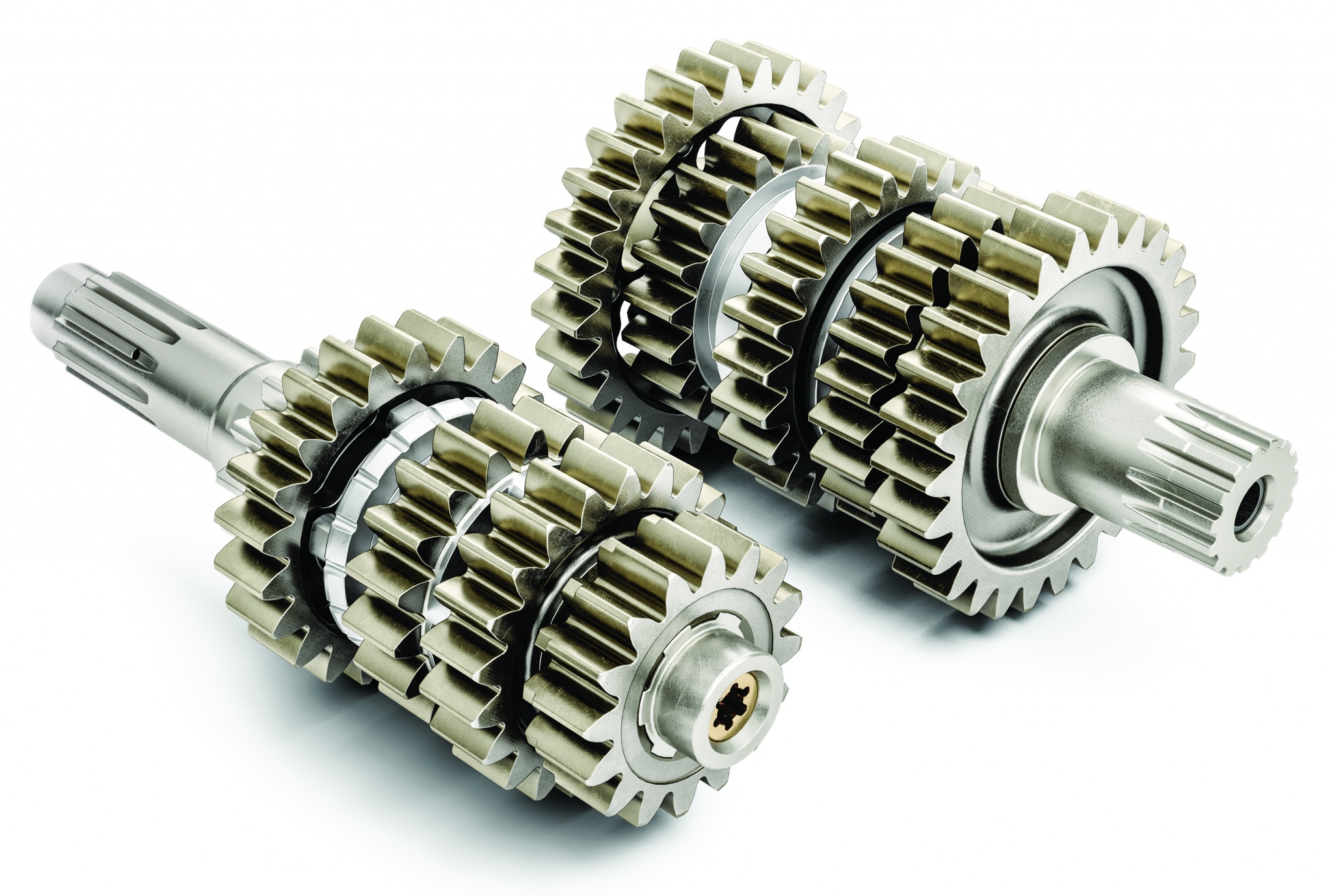 The gearbox features wider gears for more durability.
The gearbox features wider gears for more durability.
(19) Why was the gearing changed from 13/49 to a two-tooth-lower 13/51? In part because the primary gear ratio went from 31/76 in 2022 to 19/72 in 2023. When the new primary gear ratio is combined with an all-new transmission with wider gears and a lower rotating speed, the power difference can be felt.
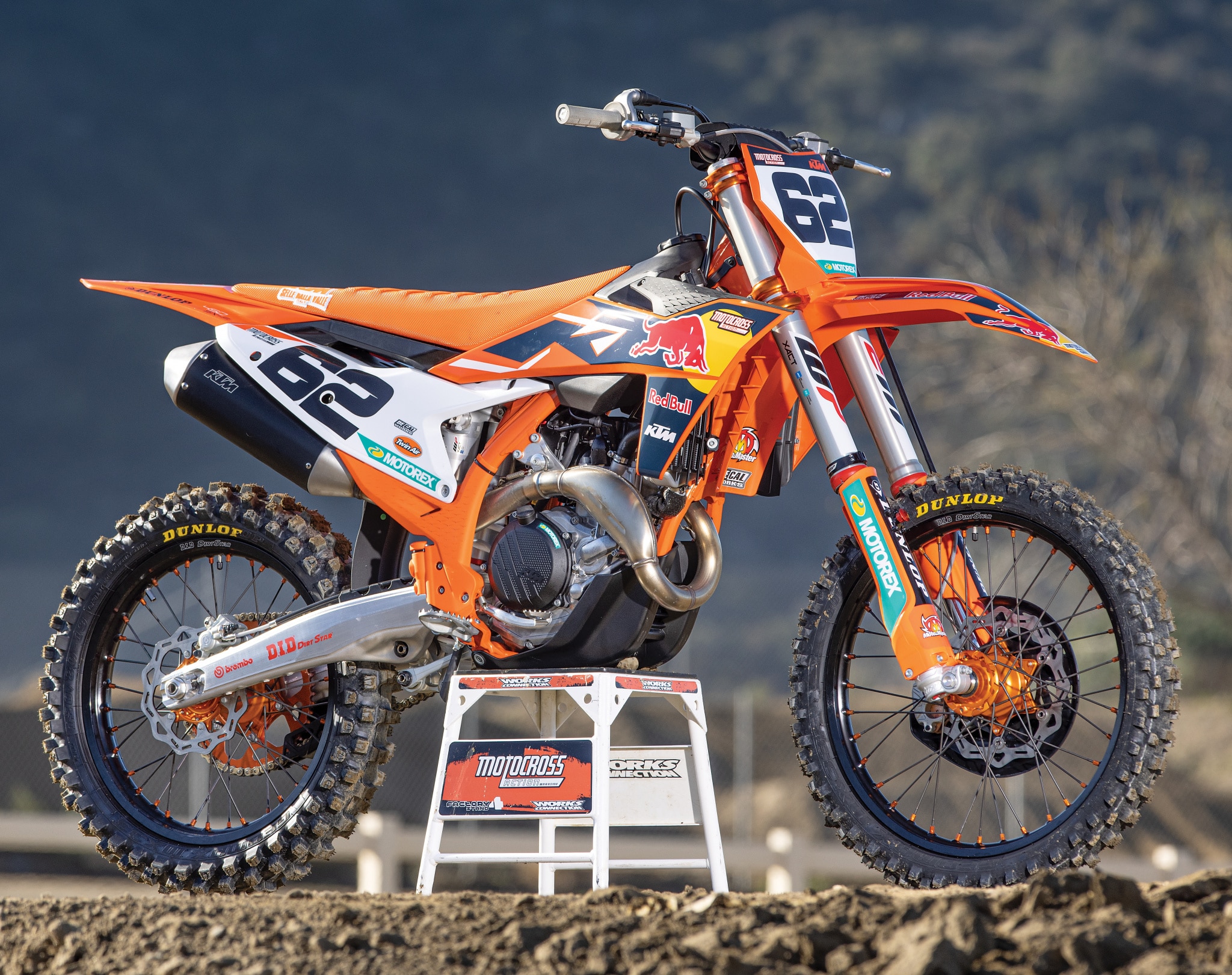 Since racers will be living with the technical changes made to the 2022-1/2 Factory Edition for the next four model years, KTM engineers wanted to move motocross design forward with advancements in bodywork, electronics, ergonomics, power, ease of use and overall design. They did a pretty good job.
Since racers will be living with the technical changes made to the 2022-1/2 Factory Edition for the next four model years, KTM engineers wanted to move motocross design forward with advancements in bodywork, electronics, ergonomics, power, ease of use and overall design. They did a pretty good job.
(20) What is the stock triple clamp offset? The 2022-1/2 KTM 450SXF Factory Edition has both the stock 22mm offset and optional 20mm offset built into the Powerparts Factory split triple clamps (offset is the distance from the center of the fork tubes back to the center of the steering stem). Less offset (20mm) increases trail and provides more straight-line stability, while more offset decreases trail and makes the bike turn quicker. Most MXA test riders leave the triple clamps in the stock offset. All you have to do to change the offset is turn the stem 180 degrees.






Comments are closed.